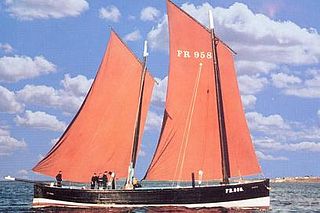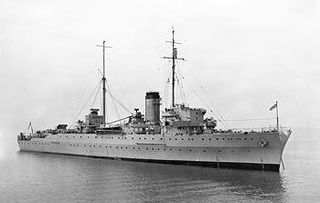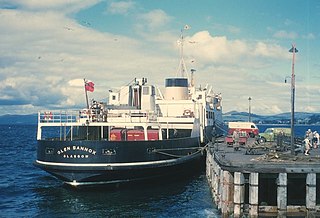The Northern Meeting is a gathering held in Inverness, Scotland, best known for its solo bagpiping competition in September.

The Clyde puffer is a type of small coal-fired and single-masted cargo ship, built mainly on the Forth and Clyde canal, and which provided a vital supply link around the west coast and Hebrides of Scotland.

Michael, popularly known as Great Michael, was a carrack or great ship of the Royal Scottish Navy. She was the largest ship built by King James IV of Scotland as part of his policy of building a strong Scottish navy.
Pibroch, piobaireachd or ceòl mòr is an art music genre associated primarily with the Scottish Highlands that is characterised by extended compositions with a melodic theme and elaborate formal variations. Strictly meaning "piping" in Scottish Gaelic, piobaireachd has for some four centuries been music of the Great Highland Bagpipe. Music of a similar nature, pre-dating the adoption of the Highland pipes, has historically been played on the wire-strung Gaelic harp and later on the Scottish fiddle, and this form is undergoing a revival.

Reaper is a restored historic Fifie herring drifter which is registered by the National Historic Ships Committee as part of the National Historic Fleet of the UK, and currently operates as a museum ship.

William Denny and Brothers Limited, often referred to simply as Denny, was a Scottish shipbuilding company.

RMS Empress of Japan was an ocean liner built in 1929–1930 by Fairfield Shipbuilding & Engineering Company at Govan on the Clyde in Scotland for Canadian Pacific Steamships (CP). This ship was the second of two CP vessels to be named Empress of Japan – regularly traversed the trans-Pacific route between the west coast of Canada and the Far East until 1942.

RMS Alaunia was an ocean liner owned by the Cunard Line. She was built in 1913 at Greenock and measured 13,405 tons gross. She was one of the three ships Cunard ordered Scotts Shipbuilding and Engineering Company to build. These three ships were RMS Andania, Alaunia, and RMS Aurania. The Alaunia was the second of these three ships. She and her sisters had only 2nd class and 3rd class.

HMS Protector was an Antarctic patrol vessel of the Royal Navy between 1955 and 1968. She was built in 1935 as a net laying ship.

MV Glen Sannox was a Clyde car ferry launched in 1957. Built for the Arran service, she spent her first 14 years there. Thereafter, she had a versatile career on the west coast of Scotland, lasting over 32 years, including providing cruises between 1977 and 1982. In 1989, she was sold for service on the Red Sea. She ran aground south of Jeddah and lay in a sunken condition from 2000.

HMS Sir Galahad was a trawler built for the British Royal Navy in 1941. Post war it was sold into civilian service and was wrecked in 1957 after running aground off the Isle of Mull.
Cap Tafelneh was a 2,266 GRT cargo ship which was built in 1920 by Burntisland Shipbuilding Company Ltd, Fife, Scotland. She was built for Joseph Lasry as Sydney Lasry. In 1931, she was sold to Compagnie Générale Transatlantique and renamed Ariège. In 1938 she was sold to Société Anonyme de Gerance D'Armement and renamed Cap Tafelneh. She was bombed and sunk at Dunkirk in 1940.
Narva was a 2,044 GRT cargo ship that was built in 1943 as Aletta Noot by Gävle Varvs & Verkstads Nya AB, Gävle, Sweden for German owners. She was seized by the Allies at Flensburg, Germany in May 1945, passed to the Ministry of War Transport (MoWT) and renamed Empire Confederation. In 1946, she was sold into merchant service and renamed Narva. On 22 December 1957, she foundered whilst going to the aid of another ship in distress.

MV Macdhui was a steel-hulled passenger and cargo motor ship built by Barclay Curle & Company at the Clydeholm Yard, Whiteinch, Scotland for Burns, Philp & Company, Limited, Sydney NSW, Australia. She was launched on 23 December 1930 and completed during March 1931. She operated with the company's Burns, Philp Line with service to Papua and New Guinea. She was sunk in 1942, as a result of damage suffered by being hit by bombs from Japanese aircraft, near Port Moresby.
Empire Curlew was a 4,273 GRT ferry that was built in 1945 as LST Mk.3 HMS LST 3042 by Harland & Wolff, Govan, Scotland for the Royal Navy. In 1947, she was renamed HMS Hunter. During the Suez Crisis in 1956, she was transferred to the Ministry of Transport and renamed Empire Curlew. She served until 1962, when she was scrapped.

SS Nyanza is a disused passenger-cargo steamer on Lake Victoria in East Africa. She is one of seven Clyde-built ships called Nyanza that were launched between 1867 and 1956.

SS Usoga is a disused cargo and passenger Lake Victoria ferry in East Africa.

SAS Transvaal was one of three Loch-class frigates in the South African Navy (SAN). She was built as HMS Loch Ard (K602) for the Royal Navy during World War II, but was transferred to the SAN in 1944 before completion and renamed as HMSAS Transvaal. The ship was completed shortly after the German surrender in May 1945 and did not participate in the war.
SS Andrew Turnbull was a Liberty ship built in the United States during World War II. She was named after Andrew Turnbull, a Scottish physician who later served as a British Consul at Smyrna, then part of the Ottoman Empire, in what is now Turkey. In 1768, he organized the largest attempt at British colonization in the New World by founding New Smyrna, Florida, named in honor of his wife's birthplace.
Agnes Maxwell MacLeod (1783–1879) also known as Mrs. Norman MacLeod was a Scottish poet. She is best known as the author of the ballad Sound the Pibroch.














